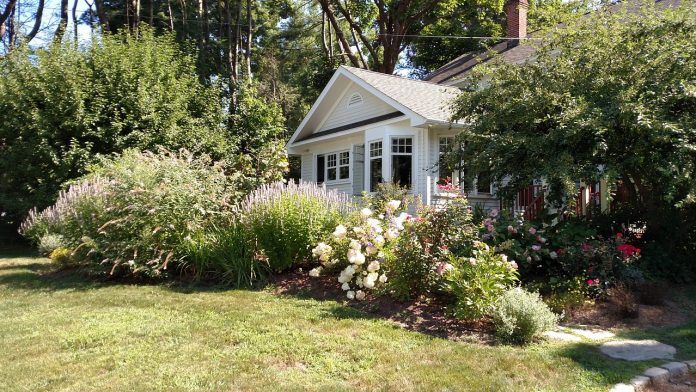“Ready?” I asked. “Here we go!” While holding up the glass of water high for all to see, I began to turn my wrist, tilting the glass slowly and steadily until the water came tumbling out.
Gasps and shrills of delight came from the students as they watched the water spill, recklessly raining down onto the table, spreading with nowhere to go but everywhere it shouldn’t be. Gravity took it as far as it could, streaming water across the table’s surface then running off into puddles on the classroom floor.
Stormwater surge
This was the second time I poured a glass of water out, and the results proved to be much more entertaining to the students. In the first demonstration, the water stayed neatly contained on the table because it was poured onto a large sponge, which absorbed almost all of it.
Using these two demonstrations to convey real-world scenarios, we discussed how the growth of a community changes its land cover and how land cover affects the quantity and quality of stormwater runoff.
The full glasses represented equal amounts of water from a 1-inch rainfall event. The first pour demonstrated rainfall on an acre of forest.
Here the raindrops are dissipated by the tree canopies and absorbed by plant roots and healthy soil — literally acting as a sponge — producing approximately 1,360 gallons of runoff, or about 10%.
Once that land is developed, however, the trees and natural landscape are removed and the soil is covered by the impervious surfaces of roadways, rooftops and parking lots. Now this same amount of rainfall on an acre of land can no longer infiltrate into the soil. Instead, it produces approximately 25,800 gallons of runoff, potentially up to 90%.
Record-breaking rainfall
Throughout this year, we have certainly seen our share of water pouring out from the skies. Yet unlike the classroom demonstrations, our real-world scenarios have brought increasingly large rain events with more frequency and intensity.
Ohio survived the wettest 12 months on record. May was the second wettest month in our nation’s history. And Lake Erie is currently holding its all-time record high water level.
Even during “normal” precipitation averages, our growth and development directly impact the amount of our stormwater runoff. With thousands of impervious acres now covering our water-slurping soil, our region is grappling to slow the consequences of increased erosion, scoured streambanks, declining water quality, and massive flooding. How can we combat our stormwater problems from excessive paving and piping?
Rooting for natives
There are many ways to help our yards become a stormwater sponge to slow it down, spread it out, and soak it in. On top of the list: more native trees and plants.
These green machines are masters of runoff reduction by intercepting sediment and pollutants, slowing the flow and impact of raindrops, infiltrating and storing rainwater, reducing erosion and releasing water through evapotranspiration.
Trees also increase the amount of organic matter in the soil through leaf litter, increasing soil’s water-holding capacity and replenishing groundwater. Depending on the tree size and species, a single tree can store 100 gallons of rainfall or more, until it becomes saturated after a one- to two-inch rain event.
Studies have also shown that when trees are combined with other natural landscaping like native plants, the amount of stormwater runoff in residential developments decreases by 65%.
Buffers give us an edge
Using native plants and trees as a buffer strip along a stream, road, farm field, ditch or property line also offers tremendous benefits. By taking your vegetation “to the edge,” you will help keep soil and nutrients on the land and out of the water.
Roots hold soil in place and reduce bank erosion. Shade helps lower water temperatures and improves aquatic habitat. Buffers also reduce mowing and add beauty while saving money and valuable resources
Saving rain for another day
Rain gardens and rain barrels are also effective ways to retain the rain. Rain gardens are attractive landscaped features with deeply-rooted perennial plants. Built as shallow depressions, they are designed to increase infiltration allowing rain to seep naturally into the ground.
These gardens can absorb 30-40% more water than a standard lawn. In addition, rain gardens provide wildlife and pollinator habitat while reducing flooding and mowing.
Rain barrels are repurposed plastic barrels that collect rooftop runoff to be used elsewhere. Rain barrels help save water, alleviate flooding, and reduce stormwater pollution while adding interest to any landscape.
Your soil sponge
A critical job of soil is to store and filter water. Healthy soil contains 50% pore space and adding compost amendments and organic matter to our soil increases its ability to store and filter water, along with increasing biodiversity. Other practices include mowing high, a height of 3.5 – 4 inches, mulching landscaped beds and trees and mowing the leaves in autumn. The old adage says “an ounce of prevention is worth a pound of cure.”
When it comes to our recent precipitation trends, planning now for increased rainfall is guaranteed to reduce runoff, improve soil health and water quality, save countless dollars, major headaches, and add beneficial beauty to our yards.
Contact your Soil and Water Conservation District for more information and recommendations. Whatever small-scale landscaping practices we add now to slow it down, spread it out and sink it in will only make our future brighter and drier!













Rain barrels sound good over here on the East coast. Farmers in the West are getting flooded out. Some states I think have regulations about saving rainwater which to me is ridiculous!